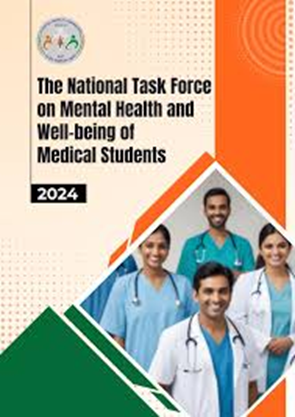- Courses
- GS Full Course 1 Year
- GS Full Course 2 Year
- GS Full Course 3 Year
- GS Full Course Till Selection
- Online Program
- GS Recorded Course
- NCERT (Recorded 500+ Hours)
- Polity Recorded Course
- Geography Recorded Course
- Economy Recorded Course
- AMAC Recorded Course
- Modern India, Post Independence & World History
- Environment Recoded Course
- Governance Recoded Course
- Science & Tech. Recoded Course
- International Relations and Internal Security Recorded Course
- Disaster Management Module Course
- Ethics Recoded Course
- Essay Recoded Course
- Current Affairs Recoded Course
- CSAT
- 5 LAYERED ARJUNA Mentorship
- Public Administration Optional
- ABOUT US
- OUR TOPPERS
- TEST SERIES
- FREE STUDY MATERIAL
- VIDEOS
- CONTACT US
Report of the National Task Force on Mental Health
Report of the National Task Force on Mental Health

A recent report by the National Task Force on Mental Health and Well-being of Medical Students-2024, released by the National Medical Commission (NMC), highlights severe mental health issues among medical students in India.
Key Highlights of the Report:
High Levels of Stress:
- Postgraduate Students: 84% experience moderate to very high stress; 64% report that workload impacts mental health significantly.
- Undergraduate Students: 27.8% have diagnosed mental health disorders. 16.2% have had suicidal thoughts.
Major Stressors:
- Work Hours: Postgraduates work more than 60 hours a week, leading to exhaustion.
- Availability: Constant duty with insufficient breaks contributes to stress.
- Mental Health Support: Lack of infrastructure and support systems within institutions.
- Substance Use: 19% of PG students use substances to manage stress.
- Financial Stress: 33.9% of UG students and 72.2% of PG students face extreme financial stress due to insufficient stipends and high educational expenses.
- Academic Pressure: Intense competition and high expectations lead to procrastination, perfectionism, and suicidal thoughts.
- Discrimination: Gender, caste, ethnicity-based discrimination, and ragging contribute to distress.
About National Medical Commission (NMC):
- Established in 2020 to replace the Medical Council of India (MCI).
- Regulates medical education and practice in India.
- Achieved World Federation for Medical Education (WFME) recognition.
Broader Mental Health Landscape in India:
Prevalence Rates:
- National Mental Health Survey (NMHS) 2015-16: 10.6% of adults suffer from mental health issues.
- Urban vs. Rural: Higher prevalence in urban areas (13.5%) compared to rural (6.9%).
Economic Impact
- Productivity Losses: Mental health disorders lead to absenteeism, reduced productivity, and increased healthcare costs.
- Poverty: Exacerbates mental health risks due to stressful living conditions.
Student Mental Health (NCERT Survey)
- Pandemic Impact: 11% felt anxious, 14% experienced extreme emotions, and 43% had mood swings.
Policy Challenges:
|
Policy Challenge |
Description |
|
Policy Neglect |
Mental health often remains a low priority due to limited political will and knowledge gaps. |
|
Lack of Core Indicators |
Minimal inclusion of mental health indicators in health metrics hampers effective resource allocation. |
|
Budget Constraints |
Mental health budget was Rs 1,000 crore in 2023 against an estimated need of Rs 93,000 crore. |
|
Legislation Shortcomings |
Despite the Mental Health Policy of 2014 and the Mental Health Act of 2017, implementation challenges persist. |
|
Human Resource Planning |
Critical shortage of mental health professionals; reliance on a few specialists. |
|
Strategic Intervention |
Need for a nuanced approach similar to India's HIV-AIDS strategy, with community engagement and comprehensive support. |
Lessons from India's HIV-AIDS Strategy:
- Data-Driven: Strategies based on real-time data and regional needs.
- Community Engagement: Significant portion of budget allocated to addressing stigma and community involvement.
- Widespread Support: Engagement of parliamentarians, media, judiciary, etc.
Initiatives Related to Mental Health in India
- National Mental Health Programme (NMHP)
- Mental Healthcare Act 2017
- National Institute of Mental Health and Neurosciences (NIMHANS)
- National Tele Mental Health Programme
- NIMHANS and iGOT-Diksha Collaboration
- Ayushman Bharat – Health and Wellness Centres (HWC) Scheme
- Kiran Helpline
- Manodarpan
- MANAS Mobile App
Sustainable Development Goal (SDG) Target 3.4: Aims to reduce premature mortality from non-communicable diseases by one-third by 2030, focusing on mental health and well-being.
Way Forward:
|
Community-Based Model |
Description |
|
Scale Up Evidence-Based Strategies |
Scale up evidence-based strategies like peer-led interventions and emergency care centers. |
|
Support Systems |
Establish dedicated counseling centers in colleges, implement mental health awareness programs, and facilitate peer support groups. |
|
Increasing Mental Health Professionals |
Expand training programs and provide incentives to address the shortage of mental health professionals. |
|
Establish an Autonomous Agency |
Consider creating an independent body for mental health similar to the National AIDS Control Organisation (NACO). |
|
Decentralizing Services |
Establish mental health facilities in rural and remote areas and use technology to enhance service delivery. |
Conclusion:
Addressing these challenges requires a multi-pronged approach, including strengthening community-based support models, increasing investment in mental health services, and expanding the training and deployment of mental health professionals. Emulating successful strategies from India's HIV-AIDS program can provide valuable insights into overcoming stigma, increasing community engagement, and ensuring effective resource utilization. Ultimately, a concerted effort from all stakeholders, including policymakers, healthcare providers, academic institutions, and the community, is needed to improve mental health outcomes and ensure comprehensive support for those in need.



